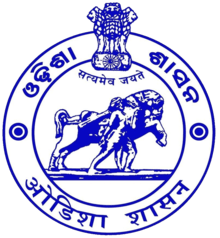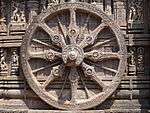Cinema of Odisha
The Odia film industry, colloquially known as Ollywood, is the Odia language Indian film industry, based in Cuttack, Odisha, India. The name Ollywood is a portmanteau of the words Odia and Hollywood.[1]
| This article is part of a series on |
| Odisha |
|---|
 |
| Governance |
|
| Topics |
| GI Products |
|
|
Districts Divisions |
|
|
Industry
In 1974, the Government of Odisha declared film making and construction of cinema theatres as an industry in the state,[2] and in 1976 it established the Odisha Film Development Corporation in Cuttack.[3]
History
Odisha has a history of filmmaking, starting from 1936. The first Odia film is Sita Bibaha, made by Mohan Sundar Deb Goswami in 1936. Drawn from the Indian epic Ramayana, the story is about the marriage of Sita and Ram. The film plot was made from a drama written by Kamapala Mishra. Prepared with a budget of only Rs 30,000, the film has 14 song sequences. Despite it being the first Odia film with several drawbacks in every section of its making, the two-hour-long movie generated great enthusiasm among the people. It was released in Laksmi Talkies, Puri. The 12-reeled film had in its cast Makhanlal Banerjee (Ram), who received only Rs 120 for his performance, Aditya Ballav Mohanty (Lakhsman), who got only Rs 35 as conveyance allowance, and Prabati Devi (Sita), who was paid the highest amount of Rs 150. This was a landmark film of the Odia film Industry.[4]
The pace of Odia film production in the initial years was very slow. After Sita Bibaha, only two films were produced until 1951. A joint consortium of landlords and businessmen who collected funds after 1948 produced those two movies. The 1951 production Roles Two Eight was the first Odia film with an English name. It was released 15 years after the first Odia film, Sita Bibaha. It was the fourth Odia film produced by Ratikant Padhi.
The eleventh Odia film, Sri Lokanath, was directed by Prafulla Sengupta and received the National Award in 1960.[4]
The same year, Prasanta Nanda won the National Film Award for Best Feature Film in Odia for his debut film, Nua Bou. His name would always be synonymous with the Odia film industry. He was present in Odia films since 1939, but he became very active only after 1976. Nanda was an actor, director, screenplay writer, lyricist and playback singer. Nanda won National Awards three times, in 1960, 1966 and 1969 for his acting in Nua Bou, Matir Manisha and Adina Megha.
Mohammad Mohsin started the revolution in the Odia film industry by not only securing the essence of the Odia culture but also changing the way the film industry watched Odia movies. Phoola Chandana was written by Ananda Sankar Das. He belongs to Cuttack. His movies heralded the golden era of the Odia film industry by bringing in freshness to Odia movies. His directorial debut was Phoola Chandana for which he won the Odisha State Film Award for Best Director. He had to his credit 16 box office successful movies in his directorial stint. He started as an actor in character roles and gave household names like Raaka to Odisha.
Amiya Ranjan Patnaik, who started his career directing Mamata Mage Mula, changed the dimension of the Odia film industry by producing big budget movies with multiple star casts, which was a new trend at that time. He introduced many newcomers, musicians, technicians and singers from Mumbai and Chennai. He also produced the National Award-winning film Hakim Babu in 1985, directed by Pranab Das. His film Pua Mora Kala Thakura, directed by Raju Mishra, was one of the biggest successes in the Odia film industry, followed by Chaka Aakhi Sabu Dekhuchi and Asuchi Mo Kalia Suna. He frequently collaborated with Raju Mishra, Akshaya Mohanty, Bijay Mohanty and Uttam Mohanty. He started the trend of producing trilingual films in the Odia film industry. Raja Rani, Paradeshi Babu and Parimahal were made in Odia, Bengali and Bangladeshi. He made a comeback as a director and made Tulasi Apa produced by his son Anupam Patnaik. Tulasi Apa was a critical success within many international festivals. This was the first biopic of Odisha based on Padmashree Tulasi Munda.
Uttam Mohanty, whose debut film Abhiman won accolades, was very successful in the 1990s. His wife Aparajita Mohanty is also an actress. Actress Nandita Das, who acted in several Hindi movies like Fire, has an Odia origin. She acted in the Susanta Misra-directed Biswaprakash, which won a National Award in 2000. Critics have named Bijay Mohanty and Mihir Das to be two of the best Odia actors so far. Siddhanta Mahapatra, a new generation star, is also successful. Barsha Priyadarshini is also another successful actress in the millennium era of Odia cinema. Anubhab Mohanty is a well-known name in Ollywood, famous for his action and romantic movies. Mrinal Sen directed an Odia film, Matira Manisha, which won a National Film Award for Best Feature Film in Odia to Prashanta Nanda. Sita Bibaha is one of the movie in Odia Cinema made in 1936 which is almost nearer to the 1st Indian talkie cinema "Alam Ara" made in 1930.
Notable people of the Odia film industry
Actors
- Akash Das Nayak
- Anubhav Mohanty
- Arindam Roy
- Babushan Mohanty
- Sritam Das
- Bijay Mohanty
- Dukhiram Swain
- Hara pattanayak
- Jayiram Samal
- Mihir Das
- Papu Pam Pam
- Prasanta Nanda
- Sabyasachi Mishra
- Sadhu Meher
- Sarat Pujari
- Shreyan Nayak
- Siddhanta Mahapatra
- Sriram Panda
- Uttam Mohanty
Actresses
- Anu Chowdhury
- Aparajita Mohanty
- Archita Sahu
- Barsha Priyadarshini
- Bhanumati Devi
- Bhoomika Dash
- Elina Samantray
- Mahasweta Ray
- Naina Das
- Nandita Das
- Prakruti Mishra
- Rachana Banerjee
- Riya Dey
- Tandra Ray
- Tamanna Vyas
Directors
- Ashok Pati
- Bijaya Jena
- Biswanath Rath
- Hara Patnaik
- Mohammad Mohsin
- Nila Madhab Panda
- Nirad N. Mohapatra
- Mehmood Hussain
- Prashant Nanda
- Ravi Kinagi
- Sabyasachi Mohapatra
- Sanjay Nayak
- Sisir Mishra
- Susant Mani
Music directors
Screenwriters
Singers
Art directors
Awards
- Odisha State Film Awards[5]
- National Film Award for Best Feature Film in Oriya[6]
- National Film Award for Best Supporting Actress (1987) - Manjula Kanwar for Bhanga Silata[7]
- National Film Award for Best Child Artist (1994) - Tarasankar Misra for Lavanya Preethi[8]
- Filmfare Awards East[9][10]
See also
- List of Oriya films
Citations
- "History Of Oriya Film Industry". www.fullorissa.com. Archived from the original on 29 March 2014. Retrieved 23 October 2008.
- "Position of Oriya Film Industry". Directorate of Film Festivals.
- Nanda, Jayanta K. (2001). Industrial Development. Sarup & Sons. p. 146. ISBN 978-8176252539.
- "Orissa Cinema :: History of Orissa Cinema, Chronology of Orissa Films". orissacinema.com. Archived from the original on 5 July 2008. Retrieved 23 October 2008.
- Palit, Ashok. "For 29th Odisha state Film Awards only Eighteen main stream [sic] film has been entered for competition". Odisha News Times. Retrieved 5 February 2019.
- "National Film Awards: 'Hello Arsi' best Odia feature film". 13 April 2018. Retrieved 5 February 2019.
- "34th National Film Awards – 1987" (PDF). Directorate of Film Festivals. p. 29. Archived from the original (PDF) on 17 October 2014. Retrieved 5 July 2013.
- "National Film Best Child Artist Award – Silver Lotus Award For Best Child Artist". www.awardsandshows.com. Retrieved 5 February 2019.
- "Filmfare Awards East 2018: Bishorjon, Mayurakshi named Best films". www.indiatvnews.com. 19 February 2018. Retrieved 5 February 2019.
- "Jaya returns from Bangladesh to attend Jio Filmfare Awards East 2018". Daily Sun. Retrieved 5 February 2019.
General sources
- Ghosh, Kartick Kumar (1984). Oriya Chalachitrara Itihas. Odisha Book Store. Contains information on films from 1934 to 1984.
